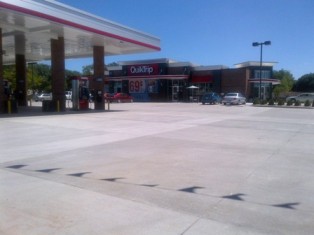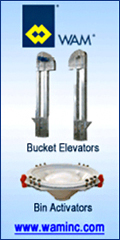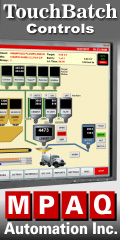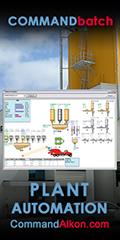NRMCA e-news
National Ready Mixed Concrete Association
NEWS LINKS
The combination of an extensive power outage that affected the metropolitan Washington, DC, area and the July 4 holiday prevented E-NEWS from being distributed last week. Held over items are included in this edition.
An Illinois-based NRMCA producer member has begun replacing some of its rear discharge mixer trucks with a fleet fueled by compressed natural gas. Mokena-based Ozinga Ready Mix Concrete held a press conference in late June in conjunction with South Shore Clean Cities. Company officials expect the savings in fuel costs will give them a return on their investment in just three years. "Natural gas far exceeded any other option available," Tom Ozinga said. Compressed natural gas will help the company reduce its reliance on foreign oil, reduce its diesel emissions and reduce the overall cost of fuel.
Source: A June 29 article in The Herald-News. Read more.
Who is Rachid Zoghaib and why is he excited about pervious concrete? Well, Mr. Zoghaib is commissioner of the Cleveland Water Pollution Control, the service that maintains Cleveland's sewer lines. He and his colleagues are searching for ways to reduce the amount of rainwater that pours through the city's street catch basins. Enter pervious concrete. Cleveland rocks, indeed.
Source: A June 22 broadcast by Ohio's News Channel 5. Read more.
One Wisconsin resident has a pretty reliable way of judging how the economy in his neck of the woods is doing. Watching mixer trucks roll by. "From the mid-1990s through 2008 concrete trucks from Lycon, PAC, Churchill and Beloit Redi-Mix were as common on the road as late-model Cavaliers. They were everywhere!," writes Steve Knox on a blog called Gen-X in J-Ville (that's Janesville, WI, for the rest of us). And after more than a couple of bleak years, he now sees a steady stream of front discharge mixers. "Sure a sight for sore eyes" as he put it. We couldn't have said it better ourselves.
Source: The Janesville Gazette for June 23. Read more.
Rice husk ash (RHA), a byproduct of rice milling, is being used in India to create a more eco-friendly concrete recipe. "Being locally available, renewable and non-toxic, RHA contributes to the concept of green concrete," said Sixtus Paulson, a civil engineer at Travancore Titanium Products. The use of RHA has been found to create a stronger, more durable and workable concrete block while reducing the amount of cement required in the mix, making the product less expensive and greener.
Source: The July 3 news roundup by the AGC SmartBrief e-newsletter, which contained this June 29 article by The Hindu, an India-based newspaper. Read more.
PROMOTIONS
QuikTrip, a growing convenience store chain which operates in many states, has caught the attention of NRMCA senior national resource directors Jon Hansen and Vance Pool. Pool reports that the chain continues to specify concrete parking for all its stores. One of his contacts, Jason Wimberly of the Carolinas Ready Mixed Concrete Association, recently confirmed that approximately 15 new QuikTrip units were constructed
 last year in North or South Carolina and a significantly larger number are planned, with land already having been secured for the additional units. last year in North or South Carolina and a significantly larger number are planned, with land already having been secured for the additional units."It is truly a pleasure to work with a National Account like QuickTrip that understands the life cycle cost advantage of concrete and is willing to pay to build with concrete designed above the minimums so that it will last a long, long time," Pool said. "It pressure washes its lots as often as daily to make sure the stores look incredible. It has been profiled in the Harvard Business Review and they have truly exceptional business people. During a recent trip to Phoenix, a primarily asphalt market, a QuikTrip was one of the few concrete parking lots I noticed."
In the Midwest, Hansen reports that QuikTrip just opened a new store in West Des Moines that is a prototype for the company’s new "Generation 3" stores and an obvious feature in the new design is the complete use of concrete for all paving. The Generation 3 stores are larger, averaging about 5,700 square feet compared to 4,600 sf for non-Generation 3 stores. The new design has more entrances, including two in the front and two side entries to allow for better traffic in and out of the store. A larger food area in the Generation 3 store will include a touch screen for customers to place orders for hot and cold drinks, smoothies, soda and soft serve ice cream.
Currently, the Tulsa, OK-based QuikTrip has 600 stores in 10 states and will add an 11th state with the opening of a store in North Carolina next month. The company has 47 more stores under development.
For more information on the West Des Moines QuikTrip Generation 3 store, contact Jon Hansen at jhansen@nrmca.org. For information on QuikTrip corporate offices, contact Vance Pool at vpool@nrmca.org or the company Web site.
The Northern New England Concrete Promotion Association (NNECPA) recently hosted a lunch-n-learn in Lebanon, NH, featuring NRMCA Senior National Resource Director Doug O’Neill. The audience, which recently participated in an NRMCA "Design Assistance Program (DAP)" in New Hampshire, was officially introduced to the ACI 330 Guide to the Design and Construction of Concrete Parking Lots. Accompanying O’Neill was local concrete experts Steve Nurme and Jon Singleton with NRMCA producer member Carroll Concrete.
"Here we had a firm working on multiple projects for both national and local clients that has already benefitted from one DAP project, yet ultimately still specified the use of unnecessary steel reinforcement and a gravel sub-base for its client," O’Neill said. "Once there was a clear understanding of the What, How and Why of ACI 330, the concrete industry team observed a clear change in mindset of the audience."
After the presentation ended, one of the principles of the firm announced his support for proper design and suggested a partnership with Carroll Concrete and the NNECPA to develop a list of the region's decision makers from local and state municipalities, who, in many cases, thwart the use of concrete because of the misperceptions common in the Northeast.
For more information on ACI 330, contact Doug O’Neill at doneill@nrmca.org.
NRMCA Senior National Resource Director Vance Pool was recently asked to discuss pervious concrete at an Environmental Protection Agency (EPA) regional stormwater conference in Ft. Worth, TX. This EPA region includes Arkansas, Louisiana, New Mexico, Oklahoma and Texas; all states were represented in the standing-room-only audience.
"This region of the U.S. has not been a leader in using previous concrete in the past, but the level of interest and number of questions was much higher than the typical audience," Pool said. With multiple tracks of speakers and an 8:30 a.m. session, having over 50 in attendance was a pleasant surprise."
Many in the session were city engineers which is a prime audience for the message. And while the topic was pervious concrete, emphasis was also given to the sustainable characteristics and cost competitiveness of traditional concrete pavements, Pool noted.
For more information, contact Vance Pool at vpool@nrmca.org.
NRMCA's national resource directors have an upcoming Webinar that focuses on concrete parking lots. Click on the link below to learn more or contact NRMCA's Jessica Walgenbach at jwalgenbach@nrmca.org.
ASSOCIATION & INDUSTRY NEWS
Registrants for NRMCA’s ConcreteWorks & Board of Directors' Meeting (September 16-19 in National Harbor, MD) will hear from political speaker Larry Sabato of the University of Virginia’s Center for Politics, one of the top-ranked political advisors in the country, as he opens the conference with an election update. Also speaking is Dr. Roger Tutterow of Mercer University, providing an in-depth analysis of current economic and business environments.
The closing session will feature Jeff Lanza, a former FBI Agent who investigated corruption, fraud, organized crime, cyber crime, human trafficking and terrorism. Mr. Lanza will give participants key information for protecting personal and business information and transactions in the electronic age. Also speaking is Jeremy Gregory of the Concrete Sustainability Hub at MIT. Mr. Gregory’s presentation will focus on the Building Technology Platform with a special emphasis on MIT CSH’s groundbreaking research on the use of pavements, which has received national attention for its pavement-vehicle interaction model.
The Monday awards luncheon will feature a presentation by special keynote speaker Milton Peterson developer of the National Harbor complex.
Click here for more information about NRMCA’s ConcreteWorks & Board of Directors' Meeting, including schedule information, registration and hotel or contact Jessica Walgenbach at 240-485-1152 or meetings@nrmca.org.
On July 1, without contrary action by the California State Legislature, Caltrans and related state transportation agencies were merged into a new, Cabinet-level state transportation agency. "It gives transportation a focused voice in the governor's cabinet," says Bert Sandman with Transportation California, a transportation lobbying group. The governor proposed the consolidated transportation agency as part of a government reorganization plan through the Little Hoover Commission. Under the processes of the commission, the reorganization takes place automatically unless the legislature votes the proposal down.
Although the legislature yielded to the Governor, AB 1458 (Buchanan) is working its way through the legislature and would keep the California Transportation Commission as a separate agency....On another matter, SB 878 (DeSaulnier) is also moving through the legislature and would require a study of whether an inspector general position should be created for state transportation agencies to ensure public funds are utilized "efficiently, effectively, and in compliance with state and federal laws."
Source: CalCIMA Weekly Update
Please join us on the morning of Tuesday, September 18, for a Walk for Wellness to benefit the RMC Research & Education Foundation. The event will be
 held in conjunction with NRMCA’s ConcreteWorks Conference & Expo and the Fall Board of Directors meeting. Please join us in spreading awareness of how wellness is an important element of daily life, including at the workplace. Your participation is a tremendous opportunity to also support this initiative and the Foundation at the same time. Registration will be $25 per walker and will be complimentary for drivers participating in the 7th Annual Truck Mixer Driver Championship. held in conjunction with NRMCA’s ConcreteWorks Conference & Expo and the Fall Board of Directors meeting. Please join us in spreading awareness of how wellness is an important element of daily life, including at the workplace. Your participation is a tremendous opportunity to also support this initiative and the Foundation at the same time. Registration will be $25 per walker and will be complimentary for drivers participating in the 7th Annual Truck Mixer Driver Championship.For more information and to register for the Walk, please click here. Sponsorship opportunities are also available for this event. Please click here to access the sponsorship form.
For more information or if you have questions, contact Jennifer LeFevre at 240-485-1151 or at jlefevre@rmc-foundation.org.
ENGINEERING
The following is a summary of actions from the ASTM Committees C01 on Cement and C09 on Concrete attended last month in San Diego by NRMCA staff.
C09.20 Concrete Aggregates - A minor revision was approved for ASTM C33, Specifications for Concrete Aggregates, in that aggregates for decorative concrete will have the same requirements as those used for architectural concrete. The subcommittee discussed criteria for acceptable service record for aggregates for alkali silica reactivity and some revisions might be proposed. A ballot proposing to recognize recycled crushed concrete as aggregate for use in concrete in ASTM C33 was not successful. Revisions were approved to C127 and C128, Methods for Measuring Specific Gravity and Absorption of Aggregates, to indicate that these methods were appropriate for lightweight aggregate. Revisions were in process for C88, C117, C566 and C1252 in future ballot activity.
A task group working on a specification for ground calcium carbonate and other mineral fillers for use in concrete has developed an initial proposal. However, the discussion was on whether this specification should be limited to milled limestone or broadened to include aggregate crusher fines with alternative mineralogy in this specification. No clear decision was arrived at. This specification will support the use of mineral fillers in concrete, which may be used in self-consolidating concrete or for other purposes. A new rapid (5 minute) test method to determine the methylene blue index (MBI) of aggregate was balloted and is moving forward in the balloting process. The purpose of the test is to identify the presence of active clay in aggregate samples or in mineral fillers.
C09.24 Supplementary Cementitious Materials - The proposed revision to C618 that requires the reporting of calcium oxide (CaO) content and total alkali content of fly ash has passed the subcommittee and will be balloted at the main committee. The subcommittee discussed evolving legislative activity regarding the EPA proposal to address fly ash proposal and beneficial use.
C09.26 Chemical Reactions - An inter-laboratory study was recently completed for the concrete prism test, ASTM C1293 for Determining the Reactivity of Aggregates. This study will be used to update the precision statement of the method. The subcommittee is evaluating the accuracy to which the result has to be reported (to the nearest 0.001% or to 0.01%) relative to the typical acceptance criteria of 0.04%.
C09.40 Ready Mixed Concrete - No significant revisions were approved at this meeting. Ballot activity included eliminating limits on delivery time (90 minutes) and 300 revolutions. Based on the response, the subcommittee is deciding which of these to move forward in future revisions. The other item addressed automated slump measurement devices in truck mixers and water addition in transit. This item is moving forward in the balloting process. Items in line for future revisions include requirements for plant scale verification, changes to the air content table, process of resolution of disputes with strength tests, addressing reuse of fresh returned concrete and revisions to the methods used for chemical analysis of non-potable mixing water.
C09.49 Pervious Concrete - Four ASTM methods on pervious concrete have been standardized thus far – ASTM C1688 on Fresh Density, C1701 on Field Infiltration Rate, C1747 on Resistance to Impact and Abrasion and C1754 Hardened Density and Void Content. Several new items were discussed for all of the above methods. After much discussion, the subcommittee voted that a compressive strength test method should be developed even if it is more variable than normal concrete. Such a test can be used for mix qualification. A final round robin is scheduled later this summer and a subcommittee ballot is planned before the December meeting.
C09.50 Risk Management for Alkali Aggregate Reactions (AAR) - A new subcommittee ballot issued on a new practice "Determining Reactivity of Concrete Aggregates and Minimizing Risk of Deleterious Expansion" drew 13 negatives. Changes to title and scope were discussed. The item was withdrawn and will be reballoted. The standard being balloted is similar to that published by the Canadian Standards Association (CSA) and is published as an AASHTO provisional standard PP65.
C09.60 Fresh Concrete Tests - Minor revisions are in the works for most of the fresh concrete tests, none approved in this cycle. Discussion included changing the requirements for initial curing of test specimens in ASTM C31 on transportation time and handling at the lab to make it easier on lab processing of test specimens and some of these revisions will be proposed in future ballots. A precision statement has been proposed for measurement of air content using the pressure method, ASTM C231. Another proposal to revise sampling procedures in C172 by obtaining the sample in one portion received several negatives and will be revised and balloted in future. A new proposed method approaching final approval on measurement of water content of concrete using the microwave oven was on hold subject to resolution of duplication of AASHTO standard T318.
C09.61 Strength - Several revisions are in process for standards under this subcommittee. A clarification to C42 regarding measuring density of cores (which is required) will be revised based on response. A proposal to measure weight of standard cured cylinders before measuring strength in C39 received several negatives and this will be dropped. It is required to measure the weight only when requested by the specifier of the test. Testing machine verification frequency was clarified to not exceed 13 months.
C09.66 Fluid Penetration - A new conductivity test (ASTM C1760) has been developed. The procedure is similar to ASTM C1202, the "rapid chloride permeability" test. The conductivity test has several advantages – molded cylinders do not have to be vacuum saturated; the existing C1202 test set up can be used; specimens need not be epoxy coated; the conductivity measurement is performed for 1 minute as opposed to the 6 hours required for C1202 and avoids temperature rise in the specimen and the associated effect on the conductivity/resistivity measurement. For C1585 (Sorptivity test) vacuum saturation of field cores was taken as a new ballot item and negatives were discussed. There are many different resistivity (bulk and surface) test methods. Under ideal conditions their results should match. The subcommittee is likely to be developing new resistivity test methods. A new test method on drying rate of concrete was also discussed. Such a test method will provide results that can be used for service life modeling.
C09.67 Resistance to Environment - Changes to ASTM C672 - Scaling Test was discussed. A new salt scaling test which includes 7 days of sodium chloride immersion followed by freezing and thawing under ¼ in. of sodium chloride was discussed.
C01.10 Cement - ASTM C595 on blended cement has been revised to permit between 5 and 15% limestone to be characterized as Type IL blended cements. Limestone, up to 15%, can be included in ternary blended (Type IT) cements also. Revisions are being made to clarify some of the language. At this point C595 includes an annex that describes methods to qualify the blended or interground limestone for limits on methylene blue index (for presence of excessive clay) and for total organic carbon. The subcommittee may decide to eliminate these qualification requirements based on current research being performed by the Portland Cement Association. Similar revisions have been approved to the equivalent AASHTO standard for blended cements. Revisions to cement standards are coordinated by an AASHTO-ASTM Harmonization Task Group to ensure similar requirements are established in the ASTM and AASHTO versions of standards for cements.
C01.98 Sustainability Assessment - This new subcommittee in the Cement Committee (C01) has been established and had its preliminary meeting. The purpose of this subcommittee is to support the development and maintenance of standards related to methodologies and metrics for assessing sustainability in the manufacture and use of hydraulic cement. The intent is to develop a standard outlining product category rules (PCRs) for environmental product declaration (EPD) of hydraulic cement. EPDs of construction materials are used in life cycle assessment of buildings. Committee E60 is developing an encompassing standard for developing PCRs for building materials. The Portland Cement Association, an ANSI approved standards development organization, is completing a PCR standard for cement that is likely to be used by this subcommittee. The Concrete Committee (C09) is also considering establishing a subcommittee to develop a PCR standard for concrete. NRMCA is involved in the development of this standard through the Carbon Leadership Forum.
Workshops - Workshops were scheduled on two topics - on Ready Mixed Concrete Industry Perspective on Requirements for Alkali Silica Reactivity (ASR) and a second one on Geopolymer-based Cementitious Materials. In the ASR workshop NRMCA’s Colin Lobo discussed the evolution of requirements for ASR and the considerable variations on ASR requirements in specifications by state highway agencies and for other public and private work. Problems arise from the severity of some of the ASR tests to accurately capture field performance and more conservative criteria that detract from other performance requirements of concrete. Kevin Wolf with CalPortland, Steve Fleming with Prairie Materials and Nick Popoff with St. Mary’s Cement provided perspectives from the Northwest, Midwest and Canada, respectively. Jason Idekar, chairman of Subcommittee C09.50, discussed the development and general outline of the ASTM Guide for ASR, based on AASHTO provisional standard PP65.
For more information, contact Colin Lobo at clobo@nrmca.org.
NRMCA is notifying interested parties of an update to the required forms to complete for certification of delivery vehicles for the NRMCA Plant Certification Program (a link to the revised NRMCA’s Fleet Inspection Reporting Form is below). This form has to be used for initial certification and to re-certify delivery vehicles. NRMCA will not accept submission of older forms. Since the certification of the concrete production facility is valid for a period of two years, the delivery vehicles shall be re-inspected during the certification period of the production facility to maintain its certification status.
The NRMCA program does permit two options – Option A where the inspection is performed by the company and audited by the inspecting engineer and Option B where the delivery vehicles are inspected by the inspecting engineer who performs the plant inspection. Certification expiration for the delivery vehicles is 14 months from the date of inspection to allow for a nominal annual inspection. NRMCA recognizes that the delivery vehicles are an integral part of the production process and cannot issue certification for production facilities without certified vehicles.
The Check List includes provisions for inspection and certification of truck mixers, agitators and non-agitating units. The delivery fleet inspection requires that not more than one unit or 10 percent of the units, whichever is greater, to be used at the plant fails to meet requirements. A copy of the current Plant Certification Check List (Eleventh Revision) is only provided to inspectors approved to perform inspections for the program. A listing of approved inspectors is available on the NRMCA Web site.
For additional information on the NRMCA Plant Certification program contact Karen Bean at kbean@nrmca.org or visit the NRMCA Web site.
NRMCA Vice President, Technical Services, Karthik H. Obla, Ph.D., was presented last month in San Diego an award by ASTM Committee E06 on Sustainability for his leadership of Subcommittee C09.49 on Pervious Concrete, part of Committee C09 on Concrete and Concrete Aggregates. Under Obla’s leadership, the development of four standards for pervious concrete have been developed at a relatively rapid pace since the first meeting of the subcommittee in December 2006.
The standards for pervious concrete include C1688/C1688M (density of fresh concrete), C1701/C1701M (infiltration rate of in-place pervious concrete), C1747/C1747M (resistance to degradation by impact and abrasion) and C1754/C1754M (density and void content of hardened pervious concrete). ASTM International Committee E60 on Sustainability has established the E60 Award of Appreciation to recognize efforts and accomplishments in sustainability in other ASTM committees. The committee honored four other ASTM members with these awards for their service to ASTM International and dedication to sustainability standards.
Anthony E. Fiorato, Ph.D., P.E., a consultant and executive director of the Slag Cement Association, was honored with the ASTM International 2012 William T. Cavanaugh Memorial Award for his outstanding leadership and contributions in promoting and strengthening the national and international voluntary standards system. The award commemorates W.T. Cavanaugh, chief executive officer of ASTM from 1970 to 1985 and is one of ASTM International’s most prestigious awards. Fiorato, an ASTM fellow and Award of Merit recipient, actively participates in the work of ASTM International. He currently is chairman of the Executive Committee of the Cement and Concrete Reference Laboratory and serves on Committees C01 on Cement, C09 on Concrete and Concrete Aggregates, and E36 on Accreditation and Certification.
On behalf of both ASTM International and ACI, Fiorato has made presentations and given lectures to technical and nontechnical groups on cement and concrete technology, test methods, codes and standards, and structural applications and performance. Both groups have honored Fiorato with several awards. He received the ASTM Katharine and Bryant Mather Award in 2007 and C09 awards of appreciation in 2007, 2008 and 2009. He became a C09 Honorary Committee Member in 2010. Fiorato has received ACI honors as well: the Henry L. Kennedy Award in 2002, the A.J. Boase Award in 1999 and the Henry C. Turner Medal in 1997. Fiorato was also inducted into the National Academy of Engineering in 2008. Before retiring in 2007, Fiorato served as president and chief executive officer of CTLGroup. Dr. Fiorato is an active member of the NRMCA Research Engineering and Standards Committee (Courtesy: PCA Executive Report).
NRMCA's Engineering Department will teach its annual introduction to concrete fundamentals for those who need a broad overview of technical and operations essentials. The curriculum is appropriate for sales reps, dispatchers, administrative/home office and mid-level staff as well as those in an executive function whose jobs do not relate to concrete per se but who should have knowledge of the industry. This class is NOT appropriate for technical ready mixed concrete personnel.
The workshop will be held October 2-4 at the RMC Research & Education Foundation Center in Silver Spring, MD. The attendees’ exam will be the morning of October 5. For those working toward their NRMCA STEPS® CCPf certification in Sales and Marketing Track, this is a required class. For others working toward CCPf certification in other STEPS tracks, the class is the qualifying prerequisite or an elective.
Click here for more information, including registration options and staff contact.
OPERATIONS, ENVIRONMENTAL, SAFETY & HR
NRMCA will conduct The Effective RMC Supervisor, October 23-25 in Silver Spring, MD. Class audience is driver supervisors, operations, fleet and QC supervisors. Content includes hands-on exercises to develop solid procedures and communication skills to deal with front line employees. The class goal is to increase daily operations efficiency and reduce front line employment liabilities.
The certification program fulfills a requirement for NRMCA's Operations and Production Track in the STEPS© program. Development of this workshop was funded by the RMC Research & Education Foundation.
Click here for registration options and NRMCA staff contact for more information.
NRMCA's Environmental Excellence Awards competition offers producers national recognition for outstanding contributions to protecting the environment and maintaining sound management practice in their operations. The program salutes companies that have not only met, but surpassed, governmental compliance measures and demonstrated a commitment to environmental excellence through plant and staff investment.
Any NRMCA member company producing ready mixed concrete from a fixed plant location in the U.S., its territories or Canada is eligible to enter. Awards will be determined upon individual plant merits; companies may choose to enter plants from any or all of the five production volume categories. In an effort to go "paperless," entries must be submitted via e-mail or mailed on a CD. Awards will be presented to plants that have best demonstrated environmental excellence and innovative management. Winning entrants will be honored at the Awards luncheon at NRMCA‘s ConcreteWorks in National Harbor, MD, in September.
Entries will be reviewed by a panel consisting of regulatory officials and industry and environmental consultants and judged based on an electronic narrative covering 11 criteria. Judges depend heavily on electronic images of submitted plants to complete their evaluations. Participants are required to submit electronic images that clearly demonstrate environmental systems and processes and at least one image that offers a broad view of the plant site. Entries must be received no later than Tuesday, July 31.
Click here to access the entry form from NRMCA's Website, along with a list of past winners and staff contact.
Applications for the 2012 NRMCA Mixer Driver Championship are due on Tuesday, July 31. The contest will be held in September as part of NRMCA's ConcreteWorks Conference & Expo held just outside Washington, DC.
To obtain an application form or for more information, contact Karen Bean at kbean@nrmca.org or Gary Mullings at gmullings@nrmca.org.
GOVERNMENT AFFAIRS
On June 29 after 1,003 days and nine extensions, Congress authorized a new surface transportation program, Moving Ahead for Progress in the 21st Century or MAP-21 (H.R. 4348). The House voted 373 to 52, while the Senate voted 74 to 19. This newest program will cover 27 months, totaling roughly $110 billion. Its passage will allow for continued funding of transportation construction projects and provide more economic certainty to the industry.
On June 13, just 16 days before MAP-21’s passage, NRMCA participated in another transportation rally on Capitol Hill to help advocate for passage when it appeared Congress was stalled in political gridlock. With a backdrop of half a dozen concrete mixer trucks, NRMCA was joined by other transportation construction industry representatives, a handful of senators and NRMCA Vice Chairman Bill Childs (president & CEO of Chaney Enterprises) who gave remarks about the necessity for a new transportation program.
Although NRMCA supported passage of the final bill, the bill contained some shortcomings and, therefore, was bittersweet. Unfortunately, not included in the final bill was NRMCA supported language which would have replaced EPA’s proposed hazardous waste label for fly ash with new disposal standards at the state level. As well, Congress included a provision which directs the U.S. Department of Transportation (DOT) to promulgate a rule mandating commercial motor vehicles (CMVs) install and use electronic on-board recorders (EOBRs) for compliance with hours of service (HOS) regulations. However, immediately following the passage of the EOBR mandate in MAP-21, the House agreed to an amendment to a transportation appropriations bill (H.R. 5972) that prohibits DOT funding for promulgating rules that mandate EOBRs, GPS units, and event data recorders in CMVs and passenger vehicles.
In light of these two conflicting votes, it is clear the EOBR fight is not over. NRMCA will continue to press hard for further positive outcomes and to seek more significant policy changes that benefit the industry on EOBRs.
For more information please contact NRMCA’s Kevin Walgenbach at kwalgenbach@nrmca.org.
On June 29,Congress passed a new 5-year authorization of the National Flood Insurance Program (NFIP), which was attached to the transportation bill. Of importance to the ready mixed concrete industry, the new NFIP authorization contains NRMCA-drafted language directing the Federal Emergency Management Agency (FEMA) to study whether more robust building codes can be used as criteria for participation in the NFIP.
The passage of this language culminates NRMCA’s 5-year effort, among several other efforts, to shape a new environment open to greater use of stronger building codes. The FEMA study will be completed and presented to Congress within the next six months.
For more information, contact NRMCA’s Kerri Leininger at kleininger@nrmca.org.
To read government affairs-related stories that relate to the ready mixed concrete industry for the week of July 2 - 6, please click here.
If you would like to receive this weekly updated link in a separate e-mail, or if you have questions or comments about the roundup, contact NRMCA’s Kevin Walgenbach at kwalgenbach@nrmca.org.
PRODUCTS & SERVICES
The July Internet Spotlight, good through Tuesday, July 31, features two essential mixer truck driver publications:
Please use Discount Code ISJULY12 to receive the online discount.
CALENDAR
*Please note that e-mail and direct links to each event listed below can be accessed from NRMCA's Web site.
July 23, Sacramento, CA
Concrete Safety Course
Email: Karen Bean, 888-84-NRMCA, x1168
July 26, Webinar
ACI 330 R-08 – The Gold Standard of Concrete Parking Lot Design
Email: Jessica Walgenbach, 888-84-NRMCA, x1152
July 26, Acme, MI
Slabs: We've Got You Covered
Contact: Concrete Foundations Association's Ed Sauter, esauter@cfawalls.org
August 6-9, Online Course
Pervious Concrete—A Stormwater Solution
Email: Shawnita Dickens, 888-84-NRMCA, x1154
August 9, Webinar
Streets and Local Roads
Email: Jessica Walgenbach, 888-84-NRMCA, x1152
August 14, Webinar
Introduction to Concrete Pavement Analyst Software
Email: Jessica Walgenbach, 888-84-NRMCA, x1152
August 14, Webinar (Part 2 on August 21)
Designing & Specifying Pervious Concrete
Email: Jessica Walgenbach, 888-84-NRMCA, x1152
August 14-17, Silver Spring, MD
Plant Manager Certification Course
Email: Shawnita Dickens, 888-84-NRMCA, x1154
August 21, Webinar
The Quantifiable Advantages of Concrete Parking Lots
Email: Jessica Walgenbach, 888-84-NRMCA, x1152
August 21, Webinar (Part 2)
Designing & Specifying Pervious Concrete
Email: Jessica Walgenbach, 888-84-NRMCA, x1152
August 27-30, Online Course
Design of Concrete Pavements
Email: Shawnita Dickens, 888-84-NRMCA, x1154
September 4, Webinar
Introduction to Concrete Pavement Analyst Software
Email: Jessica Walgenbach, 888-84-NRMCA, x1152
September 4, Webinar (Part 2 on September 11)
Designing & Specifying Pervious Concrete
Email: Jessica Walgenbach, 888-84-NRMCA, x1152
September 5-7, Silver Spring, MD
NRMCA Concrete Durability Course
Email: Jessica Walgenbach, 888-84-NRMCA, x1152
September 11, Webinar
The Quantifiable Advantages of Concrete Parking Lots
Email: Jessica Walgenbach, 888-84-NRMCA, x1152
September 11, Webinar (Part 2)
Designing & Specifying Pervious Concrete
Email: Jessica Walgenbach, 888-84-NRMCA, x1152
September 16-19, Metro Washington, DC
2012 NRMCA’s ConcreteWorks & Board of Directors Meeting
Email: Jessica Walgenbach, 888-84-NRMCA, x1152
September 20, Webinar
Streets and Local Roads
Email: Jessica Walgenbach, 888-84-NRMCA, x1152
October 2-5, Silver Spring, MD
CCSP Module I: Concrete 101
Email: Shawnita Dickens, 888-84-NRMCA, x1154
October 23-25, Silver Spring, MD
Effective RMC Supervisor Course
Email: Shawnita Dickens, 888-84-NRMCA, x1154
November 1, Webinar
Streets and Local Roads
Email: Jessica Walgenbach, 888-84-NRMCA, x1152
November 5-9, Silver Spring, MD
Technical Short Course
Email: Karen Bean, 888-84-NRMCA, x1168
December 4-6, Silver Spring, MD
CCSP Module II: Customer Business Knowledge
Email: Shawnita Dickens, 888-84-NRMCA, x1154
December 4-6, Orlando, FL
Environmental Professional Certification Course for the Ready Mixed Concrete Industry
Email: Jessica Walgenbach, 888-84-NRMCA, x1152
December 11-14, Denver
Plant Manager Certification Course
Email: Shawnita Dickens, 888-84-NRMCA, x1154
December 12-13, Doha, Qatar
International Concrete Technology Forum
Email: Lionel Lemay, 847-918-7101
2013
February 19-21, Silver Spring, MD
CCSP Module III: General Business Knowledge
Email: Shawnita Dickens, 888-84-NRMCA, x1154
March 3-5, San Antonio, TX
NRMCA Annual Convention
Email: Jessica Walgenbach, 888-84-NRMCA, x1152
March 19-21, Silver Spring, MD
CCSP Module IV: Sales Fundamentals
Email: Shawnita Dickens, 888-84-NRMCA, x1154
May 6-8, San Francisco
International Concrete Sustainability Conference
Email: Lionel Lemay, 847-918-7101
May 12-15, Chicago
Fifth North American Conference on Design and Use of Self-Consolidating Concrete
|







